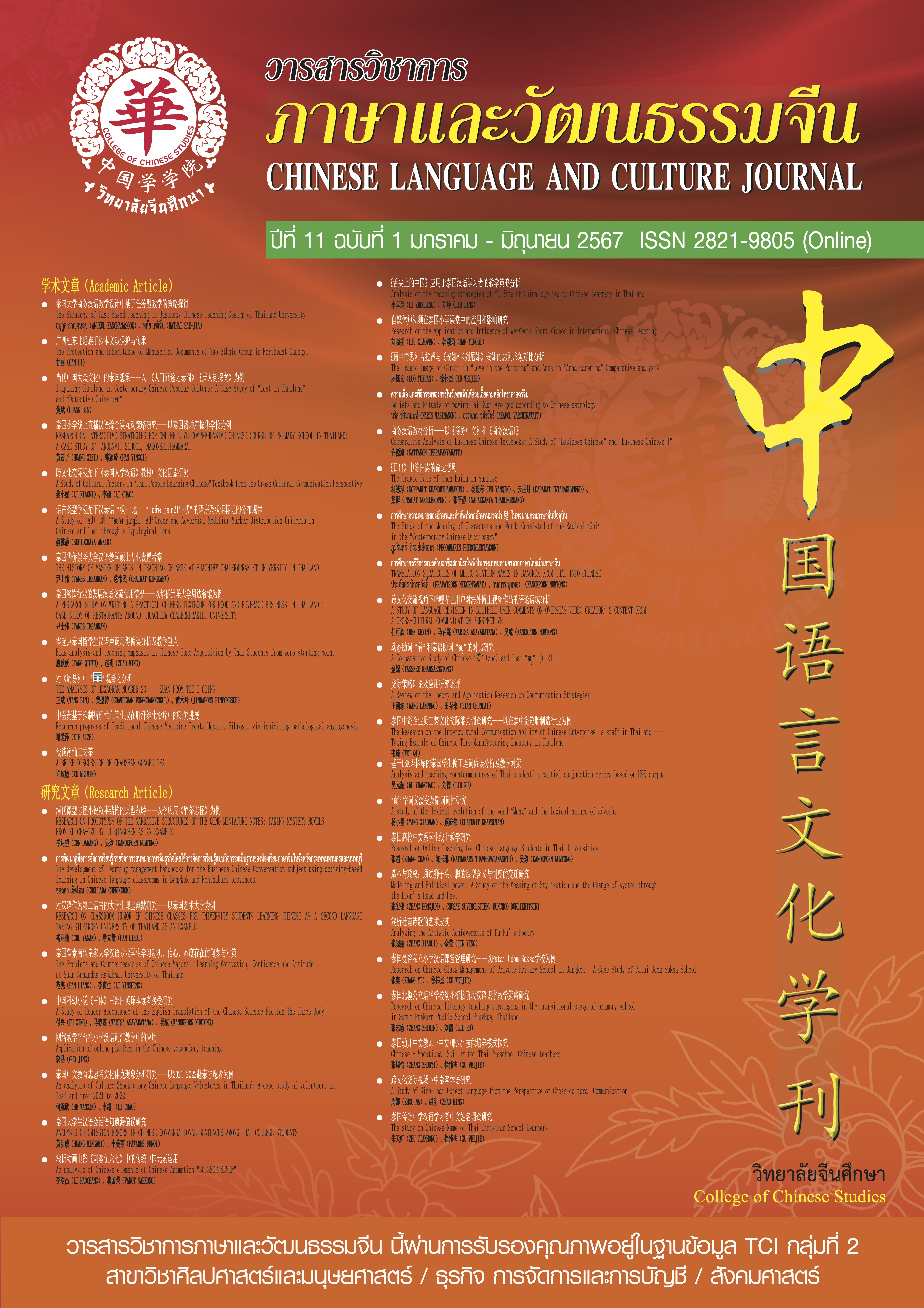The development of learning management handbooks for the Business Chinese Conversation subject using activity-based learning in Chinese language classrooms in Bangkok and Nonthaburi provinces.
Abstract
The objectives of this research are: 1. to develop learning management handbooks for the Business Chinese Conversation subject using activity-based learning in Chinese language classrooms in Bangkok and Nonthaburi provinces; and 2. to assess satisfaction with the learning management handbooks for the Business Chinese Conversation subject using activity-based learning in Chinese language classrooms in Bangkok and Nonthaburi provinces. This research employs quantitative methods. The sample group used in the study was divided into two groups: 1. Five experts in education, learning management, or measurement and evaluation areas, with a minimum of five years of working experience. This sample was selected using purposive sampling. 2. Ten instructors who utilized the learning management handbooks for the Business Chinese Conversation subject from ten schools with Chinese language classrooms in Bangkok and Nonthaburi provinces. This group was selected through simple random sampling from Chinese language classrooms that cooperated with Panyapiwat Institute of Management and offered the Business Chinese Conversation subject. The tools used to collect data are divided into two types: 1. a quality assessment form of the learning management handbooks for the Business Chinese Conversation subject, and 2. a satisfaction assessment form of the learning management handbooks for the Business Chinese Conversation subject. Data were analyzed using mean and standard deviation (S.D.). The results are as follows:
1. The quality assessment of the learning management handbooks for the Business Chinese Conversation subject using activity-based learning management revealed that the mean overall appropriateness of the book format was 4.88, with a standard deviation of 0.30. The mean overall appropriateness of the content was 4.84, with a standard deviation of 0.28. The mean overall appropriateness of application was 4.80, with a standard deviation of 0.44. All three aspects of appropriateness are at the highest level.
2. The satisfaction assessment of those who used the learning management handbooks for the Business Chinese Conversation subject using activity-based learning found that the mean overall content was 3.72, with a standard deviation of 0.95. The appropriateness of the application was found to be 3.74, with a standard deviation of 1.15. Both aspects were rated at a high level.
References
ณัฐวุฒิ สกุณี และอัมพร ม้าคนอง. (2561). “การพัฒนาเจตคติแรงจงูใจใฝ่สัมฤทธิ์และพฤตกิรรมการเรียนรู้วิชาคณิตศาสตร์ของนักเรียนมัธยมศึกษาปีที่ 3 โดยใช้การจัดการเรียนการสอนที่เน้นกิจกรรมเป็นฐาน”. วารสารอิเล็กทรอนิกสทางการศึกษา. [Online] แหล่งที่มา : https://so01.tci-thaijo.org/index.php/OJED/article/view/110544/86654 (30 มกราคม 2561 )
สุมาลี เชื้อชัย. (2551) การพัฒนารูปแบบการฝึกอบรมการเขียนแผนการจัดการเรียนรู้ด้วยกระบวนการเรียนรู้โดยการสังเกตผ่านเครือข่าย สำหรับนิสิตคณะครุศาสตร์ จุฬาลงกรณ์มหาวิทยาลัย. วิทยานิพนธ์ ค.ม. (การสอนและเทคโนโลยีการศึกษา) กรุงเทพฯ : จุฬาลงกรณ์มหาวิทยาลัย.
สำนักงานคณะกรรมการการศึกษาขั้นพื้นฐาน. (21 ธันวาคม 2565) “สพฐ. ประชุมเชิงปฏิบัติการการจัดทำ แนวทางการจัดการเรียนการสอนภาษาจีนและแนวทางการขอเปิดห้องเรียนพิเศษภาษาจีน” เว็บไซต์ สำนักงานคณะกรรมการการศึกษาขั้นพื้นฐาน. [Online] แหล่งที่มา :https://www.obec.go.th/archives/743797
อาภรณ์ ใจเที่ยง. (2553) หลักการสอน (ฉบับปรับปรุง). กรุงเทพฯ : สำนักพิมพ์โอเดียนสโตร์.
อาภันตรา แสงวงศ์. (2551) การพัฒนาคู่มือการจัดการเรียนรู้แบบ 4 MAT ร่วมกับการจัดการเรียนรู้แบบซิปปาที่มีผลต่อการคิดวิเคราะห์ ความคิดรวบยอดและผลสัมฤทธิ์ทางการเรียน วิชาคณิตศาสตร์เพิ่มเติมของนักเรียนชั้นมัธยมศึกษาปีที่ 5. วิทยานิพนธ์ ค.ม. (วิจัยและพัฒนาการศึกษา) สกลนคร : มหาวิทยาลัยราชภัฏสกลนคร.
Downloads
Published
How to Cite
Issue
Section
License
Copyright (c) 2024 Chinese Language and Culture Journal

This work is licensed under a Creative Commons Attribution-NonCommercial-NoDerivatives 4.0 International License.
บทความที่ได้รับการตีพิมพ์เป็นลิขสิทธิ์ของวารสารภาษาและวัฒนธรรมจีน มหาวิทยาลัยหัวเฉียวเฉลิมพระเกียรติ
บทความใน “วารสารวิชาการภาษาและวัฒนธรรมจีน” เป็นทรรศนะของผู้เขียนโดยเฉพาะ กองบรรณาธิการไม่มีส่วนในความคิดเห็นในข้อเขียนเหล่านั้น




